Introduction
Proper diagnosis of plant problems is both an art and a science. As an art, it requires lots of practice and an eye for discriminating between what is normal and what is not normal. As a science, it requires good observational skills and knowledge of plant structure and function. A combination of knowing how plants grow and recognizing unusual patterns allows the professional to think critically about what may have happened to a plant, and at what stage of development the event or disturbance occurred. This publication is for master gardeners and green industry professionals who are involved with educating and helping clients with their plant problems.
In this publication, you will see many pictures of plants with varying degrees of damage or dysfunction caused by one or more environmental stresses. Human nature will cause you to want to memorize the pictures and to diagnose every plant based on the degree to which the symptoms look like what is shown in the pictures. In reality, rarely does any plant problem look exactly like it does in a picture. Different species will respond to stresses differently. A particular stress will affect a plant differently depending on the developmental stage at which it was exposed to the stress. Often a combination of environmental or biological stresses will come to bear on a plant, and that will affect the plant’s response. Use the pictures as examples only. Combine your knowledge of plant biology with your knowledge of what is normal for a particular species or family of plants. Use your detecting skills to ask the appropriate questions and to think critically about what may have occurred to cause the symptoms presented.
The C.L.U.E.S. process described in the following pages will help guide you to towards a systematic method of diagnosing plant problems. C.L.U.E.S. stands for Collect information, Look for patterns, Use references, Eliminate common causes and State your tentative diagnosis. The tendency for people new to this process is to want to come up with an immediate diagnosis upon being presented with a plant problem. You will almost always fail with this approach. Even seasoned professionals can be foiled by “first-glance” diagnoses because they haven’t taken the time to consider all possibilities. The C.L.U.E.S. process reminds you to slow down, collect information, and observe carefully the pattern of symptoms presented to you. Like a detective, you must develop an eye for the abnormal or unusual. You will want to look at the plant closely, maybe even peeling away part of the bark or viewing a leaf with a hand lens or microscope. But you also must look at the plant as a whole, within the context of its environment and in comparison to neighboring plants. Client pictures of the plant in its habitat help tremendously in this process. If you are unable to visit the site of the plant problem, don’t hesitate to ask the client to bring back pictures. If this is not possible, asking pointed questions about the plant’s surroundings, how it is cared for and the progression of symptoms may provide you with useful information.
Keep in mind that your clients may not have the answers you need. They may unintentionally exaggerate or minimize the extent of the problem or the level of care provided to their plants. Many clients don’t observe their landscape plants on a regular basis, and a symptom they just noticed this week may have been present for months or even years. Knowing this, you should ask questions that gently lead them to think more carefully about their answers. Don’t accuse or berate your clients for providing incomplete information. Rather, gain their trust by involving them in the process, explaining why you are asking these questions and inviting them to explore the possibilities with you. A description of how a plant takes up water, for example, or how soil type, temperature or pH can affect nutrient availability will engender the trust and respect of your clients. They will have confidence in your diagnosis and will feel empowered by the knowledge you have provided in the process. In this way, you will gain a repeat customer who will return for your services again and again, and who will speak highly of your services or your place of business.
Finally, know that you won’t always have an answer, and sometimes you may be wrong. Ask your client for time to investigate the problem. Don’t hesitate to ask a colleague for a second opinion. Over time, your skills will improve and before you know it, you will be diagnosing like a professional.
Common Plant Problems in Northern Nevada: Look for C.L.U.E.S.
Collect information
Identify the plant (genus, species and cultivar) and its age. Many plant problems are unique to a species or family of plants. Know what is normal for the species. How long have you noticed symptoms? What sun and wind exposure does the plant experience? Has there been a recent disturbance? What is the watering schedule?
Look for patterns
Was there a sudden or a gradual appearance of symptoms? Are many plant species affected or only one? Are symptoms on one side or area of the plant, or all over the plant? Environmental problems (drought, cold, soils) can affect many species, and the pattern of occurrence can help you pin down the cause.
Use references
Many references exist that can help you identify symptoms or provide pictures and diagnostic keys. Keep them handy, and use them. Don’t be afraid to admit you don’t know what the problem is, and seek professional consultation when in doubt.
Eliminate the most common causes
Most plant problems in our high-desert climate are related to improper watering, heat, intense sunlight and/or poor soils. Don’t jump to conclusions and assume the worst. Asking questions about plant culture, location in the landscape and soil conditions may help you rule out some of the most common causes of plant problems. Only then should you consider more unusual diagnoses that may require further inquiry and investigation.
State your tentative diagnosis
Narrow your findings to a few possibilities based on the facts. Rarely can the precise problem be known for certain without testing hypotheses.
“Unless there is information to suggest otherwise, the best hypothesis is usually the simplest.”
-Occam’s razor
“We are to admit no more causes of natural things than such as are both true and sufficient to explain their appearances.”
-Sir Isaac Newton
Water stress
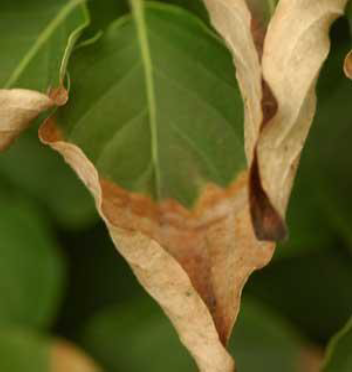
Leaf scorch can be a symptom of both under- and overwatering.
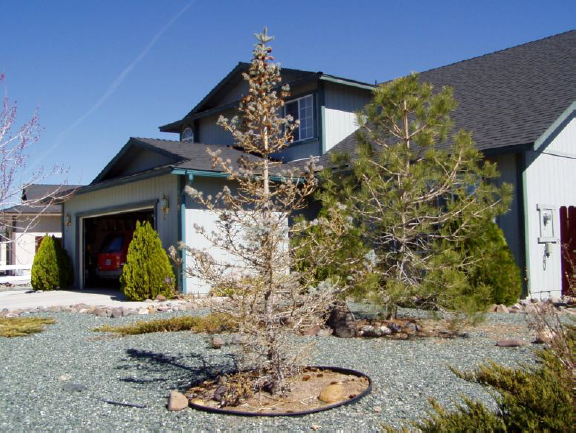
Water stress on blue spruce due to reflected heat and light makes it more susceptible to spider mites.
Identification
- Wilting
- Leaf margin death
- Leaf tip death
- Red-brown areas or whole leaf death
- Leaf drop
- Early fall color
- Branch dieback
- Bark cracking
- Trunk bleeding (some species)
- Not limited to one species in the landscape
- Plants more susceptible to pest attack
Look like:
- Under-watering
- Over-watering
- Salt injury
- Root injury
- Boron toxicity
- Herbicide injury (glyphosate)
- Insect injury (bark beetles, borers, root weevils)
Recommendations
- Water deeply and less frequently. Add more emitters to trees and shrubs.
- Reduce light-reflective surfaces.
- Place organic mulch around heat-sensitive plants.
- Provide enough space for plant roots.
- Avoid over-planting an area.
- Use separate irrigation zones for plants with different water needs.
- “Can-test” the lawn to check for even water distribution.
- Check irrigation systems regularly for breaks, leaks or clogged lines.
- Core-aerate the lawn to alleviate thatch and/or compaction.
- Split irrigation into multiple cycles if water pools on the soil or lawn surface.
Winter damage
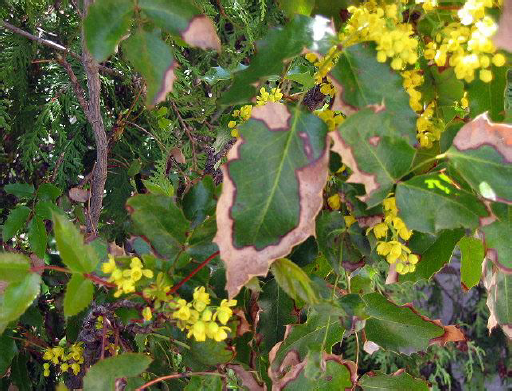
Winter burn on Oregon grape.
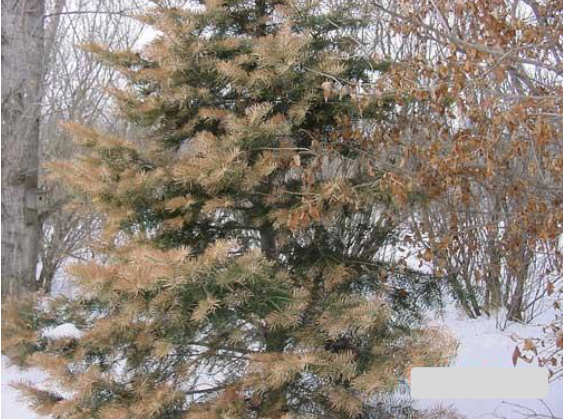
Winter burn on white pine.
Identification
- Needled and broadleaf evergreens are the most susceptible.
- Leaves, buds, flowers, fruit, bark can be affected.
- Late-season frosts are especially damaging to newly expanding leaves and buds.
- New leaves may appear water-soaked and turn black.
- Older leaves turn reddish brown or have crisp margins.
- Affected plants may fail to bloom or to set fruit.
- Growth and/or flowering may be delayed.
- Winter burn occurs due to lack of moisture and drying winds.
- Bark may split due to frost.
- Heavy snowfalls may damage or disfigure upright or columnar-form plants.
Recommendations
- Little can be done to save damaged plant parts.
- Prune out dead plant parts only. Use the ‘bend test’ to identify live tissue. Dead tissue will break rather than flex when bent. Use care when pruning conifers, as pruning into bare inner branches can leave permanent, unsightly gaps.
- Provide protection around plants when frost or snow is predicted.
- Allow ice to melt naturally from plants to avoid excessive damage.
- Water evergreen plants monthly during the winter if no snow cover or rain occurs.
- Remove built-up snow by gently shaking the stem or trunk of affected plants.
Poor soil
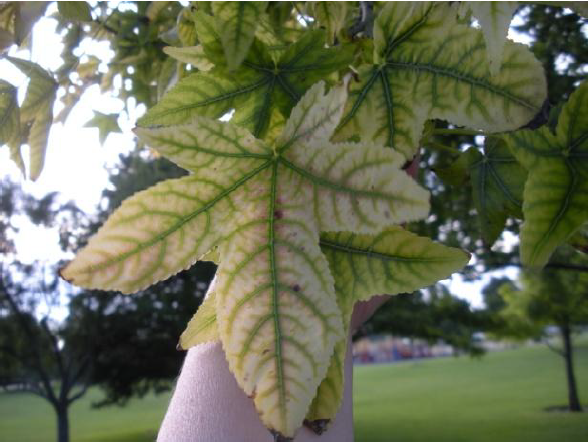
Interveinal yellowing on sweetgum due to iron deficiency.
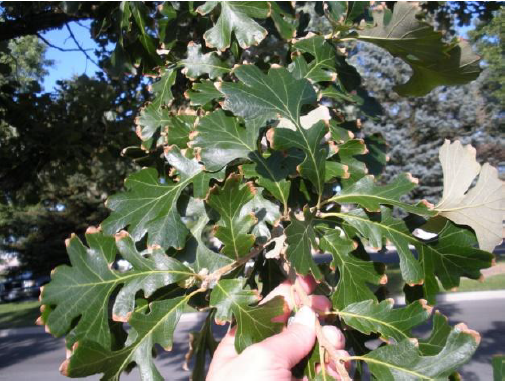
Tip browning on bur oak due to boron toxicity.
Identification
Salt
- Leaf or needle tips turn yellow, changing to brown.
- Sometimes caused by irrigation with reclaimed water.
Boron toxicity
- Leaf tips, margins, or interveinal areas may appear dark and mottled.
Alkaline (high pH)
- pH-sensitive plants develop nutrient deficiencies.
- The most common pH-related deficiencies include iron and manganese, often displayed as interveinal yellowing.
Compaction
- Water pools and cannot enter the soil causing water stress symptoms in plants.
- Forces out air and destroys soil structure.
- Caused by excessive traffic in an area or working wet soils.
- Deprives roots of oxygen and prevents their growth.
Recommendations
- Have soil tested for pH, drainage properties (texture) and salinity.
- Plant species adapted to your soil conditions. Salts can be leached below the plant root zone, but good quality water must be used and drainage should be adequate.
- Salinity problems can be diagnosed from soil samples.
- Avoid amending soils with fresh manure during the growing season. Manure should be well rotted or aged.
- Avoid over-fertilization, especially during hot, dry weather.
- Avoid tilling wet soils.
- Raised bed gardens planted in high-quality soil can be an effective strategy against poor landscape soils.
- Creating a berm for landscape plants can lift most of the feeder roots out of poor soils and provide effective drainage.
Southern/western exposure (sun & heat)
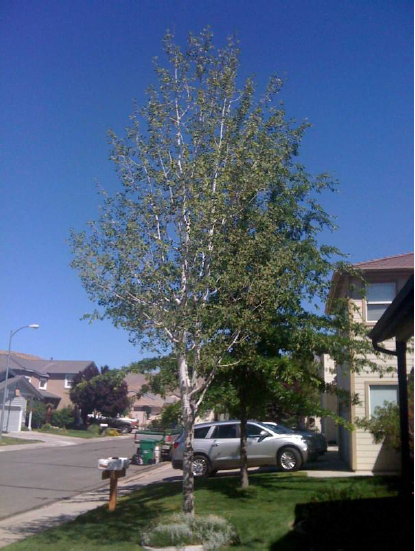
Dieback on south side of a birch tree.
Identification
- Plants show damage to the crown or trunk on the southwest side of the plant (sunscald).
- Damage from other stresses (especially water stress) may be more severe on the southwest side of plants.
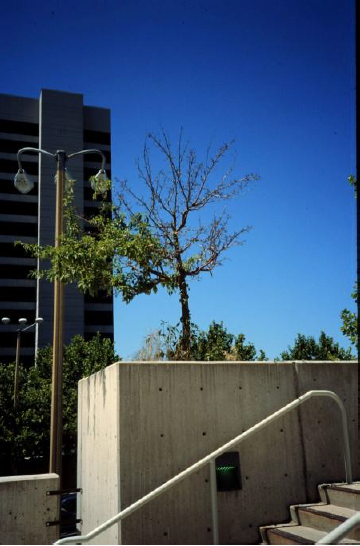
Heat stress in an urban tree surrounded by pavement and reflected light.
Recommendations
- Protect the bark of young trees with tree wrap or white latex paint.
- Minimize reflective surfaces by using organic mulches instead of rock beneath sensitive plants.
- Provide partial shade during the afternoon for sensitive plants.
- Plant species that are tolerant of the heat and high-intensity light common to high-elevation and urban environments.
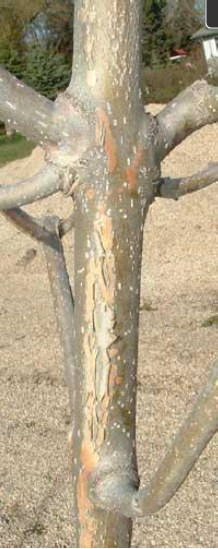
Sunscald on bark of young green ash.
Poor drainage or other root issues
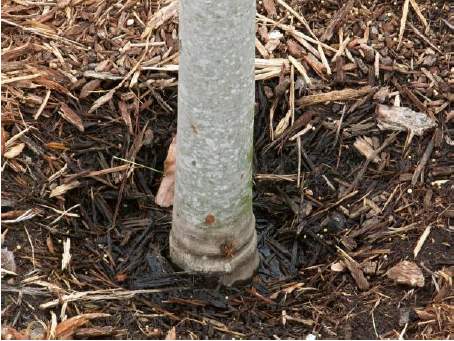
Drainage and girdling problem hidden by mulch.
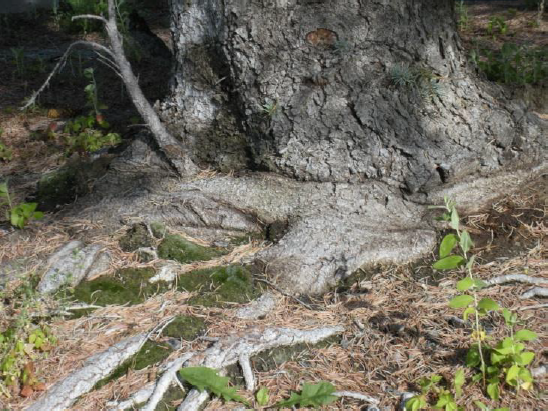
Girdling roots on blue spruce.
Identification
Roots can’t get enough air
- Over-watering
- Heavy clay soils
- Soil compaction
- Mulch or soil piled up around the plant stem
Other root damage
- Girdling or circling roots
- Construction damage causing loss of roots
- Tree roots constrained by planters or cement
- Organisms that chew on roots (root weevils, grubs, nematodes)
Symptoms
- Roots can no longer absorb nutrients causing nutrient deficiency symptoms.
- Slow growth
- Yellowing leaves (looks like nitrogen deficiency)
- Shoot dieback often, but not always, occurs on the side of root damage.
Recommendations
- Use the “can test” to check that the proper amount of water is applied evenly to lawns.
- Adjust the irrigation schedule seasonally (water less frequently in spring and fall).
- Check to see if mulch is hiding poor drainage issues.
- Allow the soil to dry between irrigation events.
- Install French drains above a hardpan layer, if present.
- Straighten circling roots before the plant is installed in the landscape.
- Remove burlap and wire from the top third to half of the plant root ball.
- Do not, or only minimally, amend the soil when planting new trees or shrubs, or else the roots may not grow into the native soil.
- Core-aerate lawns once or twice per year (spring and/or fall).
- Fence or otherwise protect the area beneath tree canopies during construction events.
Herbicide injury
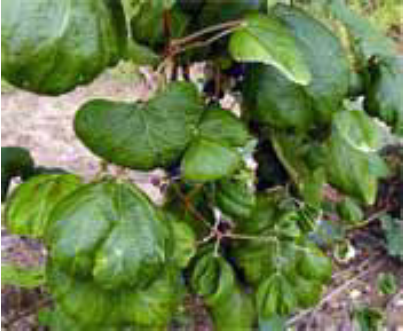
2,4-D damage causes cupping and twisting of leaves and shoots.

Glyphosate can drift and penetrate the thin bark of young trees.
Identification
- Selective broadleaf herbicides such as 2,4-D and Dicamba (found in lawn herbicide and fertilizer combination or “weed-and-feed” type products) cause twisting and cupping of shoots and leaves.
- Broad-spectrum herbicides such as glyphosate can cause leaf chlorosis (yellowing) and shortened internodes.
- Glyphosate sprayed too close to young trees may be taken up by the thin green bark and causes damage that looks like sunscald.
Looks like
- Nutrient deficiency
- Insects (esp. sucking insects – aphids and leafhoppers)
- Salt or water stress
Recommendation
- Use good cultural practices.
- Do not fertilize or over-water affected plants.
- Activated charcoal can be incorporated into soils to absorb and remove some herbicides.
- Do not spray herbicides containing 2,4-D when temperatures are predicted to go above 80⁰F.
- Do not use herbicide and fertilizer combination products (“weed-andfeed” type products) within the drip line of trees.
- Remember that tree roots can extend well beyond the drip line of trees. Products containing systemic herbicides applied to lawns may damage trees in the lawn.
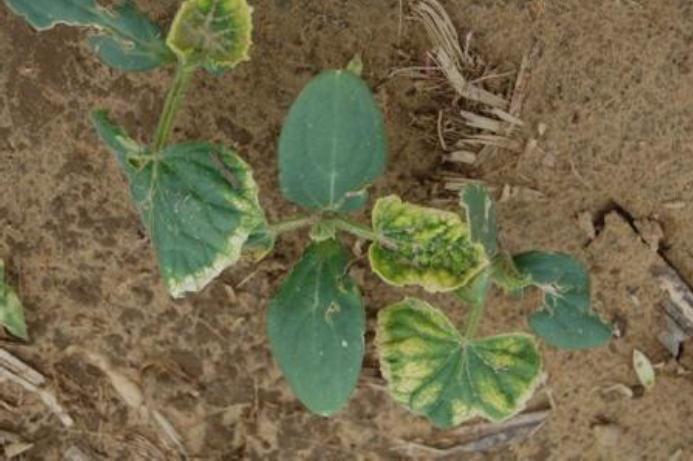
Glyphosate damage on cucurbits in the garden looks like nutrient deficiency.
References
Costello, L.R., E.J. Perry, N.P. Matheny, J.M. Henry, and P.M. Geisel. 2003. Abiotic Disorders of Landscape Plants. University of California Agriculture and Natural Resources Publication 3420.
Cranshaw, W., D. Leatherman, W. Jacobi, and L. Mannix. 2004. Insects and Diseases of Woody Plants of the Central Rockies. Colorado State University Cooperative Extension Bulletin 506A.
Harris, R.W., J.R. Clark, and N.P. Matheny. 2004. Arboriculture: Integrated Management of Landscape Trees, Shrubs, and Vines. Prentice-Hall, Upper Saddle River, NJ.
Pittenger, D.R. 2006. Retail Garden Center Manual. University of California Agriculture and Natural Resources Publication 3492.
Kratsch, H.
2011,
Common Plant Problems in Northern Nevada: Look for C.L.U.E.S.,
Extension | University of Nevada, Reno, SP-11-12


